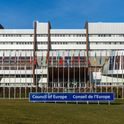In 2017 the euro area turned the tables on its critics, growing at 2.4 per cent, its fastest for a decade. But as 2018 draws to a close there is less to celebrate. First the pace of growth slackened and now it has become a crawl. As the outlook darkens, will the European Central Bank offer fresh succour when its governing council meets on 13th December?
In the first half of 2018 the slowdown in Europe’s 19-strong monetary union appeared both predictable and manageable. The euro area had expanded by a heady 0.7 per cent in late 2017. The deceleration to a quarterly rate of 0.4 per cent until June brought growth into line with underlying potential, set by productivity and labour resources. However, the position deteriorated further in the third quarter, when growth fell to a meagre 0.2 per cent.
At first sight, the slowdown in the third quarter appeared to be a blip, caused in particular by an abrupt fall in car production as the motor industry struggled to comply with a new emissions standard. Consistent with this interpretation, Germany with its big car sector did especially badly, with GDP actually falling by 0.2 per cent in the third quarter. Yet this view was too sanguine since there was weakness elsewhere in the euro area, notably in Italy where output stagnated.
More tellingly, the setback to growth is persisting into the fourth quarter. A widely watched gauge of current conditions is an output index, compiled by IHS Markit, a data provider, which is based on monthly surveys of purchasing managers. This indicator, which covers private services as well as manufacturing, fell in November to its lowest in almost four years.
Factories in particular are suffering as orders and exports dwindle. Output from them is at a virtual standstill, the most sluggish since the current economic recovery got underway over five years ago. The manufacturing sector that drives the German economy—which in turn propels the eurozone, making up almost 30 per cent of its output—is idling.
The slowdown reflects an underlying vulnerability in the euro economy: the extent to which its growth is geared to that of the global economy. It is no accident that the monetary union did so well in 2017 when world trade put on a burst of speed. For a large economic bloc, the euro area is quite open through trade to external forces. This makes it susceptible to collateral damage from the trade dispute between the US and China. Germany’s success in selling to China, now its third biggest market for goods exports (after the United States and France), comes with a catch now that the Chinese economy is coming off the boil.
None of this means that the euro area is poised to suffer yet another debilitating recession. Domestic demand especially from consumers should be sturdy enough to avoid that as the labour market continues to heal. Unemployment has fallen from a peak of over 12 per cent of the labour force five years ago to 8.1 per cent in September, its lowest for almost a decade. A mild easing in fiscal policy will also support spending. But without the extra impetus from net trade (exports less imports), which contributed about a third of growth in 2017, the pace will moderate to 1.8 per cent next year and slow further to 1.6 per cent in 2020 on forecasts from the OECD published on November 21st.
Such growth would be acceptable if the euro area had done better earlier in this decade. Instead its record since 2010 has been dismal, reflecting the double-dip recession that followed the initial downturn caused by the global financial crisis and then a recovery that was at first weak. As a result eurozone GDP grew by just 8.6 per cent between 2010 and 2017, an annual average of just 1.2 per cent. That contrasted with 16.5 per cent for Sweden and 14.8 per cent for Britain (annual averages of 2.2 and 2.0 per cent respectively), both outside the euro area. As important, the overall record for the euro area hid sharp contrasts between those economies that did better such as Germany, whose output rose by 13.7 per cent (an annual average of 1.8 per cent) and those that did poorly such as Italy and Portugal, which went nowhere over the period.
As the eurozone economy slows, eyes turn once again to the ECB, which under Mario Draghi’s leadership rescued the monetary union in its darkest hour. But addressing the European Parliament on Monday Draghi indicated that the ECB had no intention of jettisoning its intention to phase out quantitative easing—buying bonds with newly created money—by the end of the year. The Bank insists that even after it stops making new net purchases the huge stock of assets it has bought since March 2015, amounting to an eye-watering total of €2.6trn, will continue to support the economy, as will its rock-bottom interest rates.
Sticking with the plan to end QE does not rule out other action to prop up the faltering eurozone economy. The ECB could tweak its forward guidance on interest rates, indicating that they will be held longer at their current ultralow levels beyond the summer of 2019. There is some speculation that it could announce another big liquidity operation, in which it provides long-term funding to banks. The snag is that this would particularly help Italian banks and the ECB is unlikely to want to assist Italy’s populist government, which is currently at swords drawn with the European Commission over its rule-breaking budget.
The bigger worry is that growth has slowed even though monetary policy remains extraordinarily loose. The euro area enjoyed an annus mirabilis in 2017 but that was an exception to the rule. Like other advanced economies, potential growth is lower than before, held back by sluggish productivity improvements and demographic curbs on higher employment. But for the euro zone, that is exacerbated by continuing flaws in its institutions that reflect the premature birth of a currency before a state. And for that there is no quick fix.
In the first half of 2018 the slowdown in Europe’s 19-strong monetary union appeared both predictable and manageable. The euro area had expanded by a heady 0.7 per cent in late 2017. The deceleration to a quarterly rate of 0.4 per cent until June brought growth into line with underlying potential, set by productivity and labour resources. However, the position deteriorated further in the third quarter, when growth fell to a meagre 0.2 per cent.
At first sight, the slowdown in the third quarter appeared to be a blip, caused in particular by an abrupt fall in car production as the motor industry struggled to comply with a new emissions standard. Consistent with this interpretation, Germany with its big car sector did especially badly, with GDP actually falling by 0.2 per cent in the third quarter. Yet this view was too sanguine since there was weakness elsewhere in the euro area, notably in Italy where output stagnated.
More tellingly, the setback to growth is persisting into the fourth quarter. A widely watched gauge of current conditions is an output index, compiled by IHS Markit, a data provider, which is based on monthly surveys of purchasing managers. This indicator, which covers private services as well as manufacturing, fell in November to its lowest in almost four years.
Factories in particular are suffering as orders and exports dwindle. Output from them is at a virtual standstill, the most sluggish since the current economic recovery got underway over five years ago. The manufacturing sector that drives the German economy—which in turn propels the eurozone, making up almost 30 per cent of its output—is idling.
The slowdown reflects an underlying vulnerability in the euro economy: the extent to which its growth is geared to that of the global economy. It is no accident that the monetary union did so well in 2017 when world trade put on a burst of speed. For a large economic bloc, the euro area is quite open through trade to external forces. This makes it susceptible to collateral damage from the trade dispute between the US and China. Germany’s success in selling to China, now its third biggest market for goods exports (after the United States and France), comes with a catch now that the Chinese economy is coming off the boil.
None of this means that the euro area is poised to suffer yet another debilitating recession. Domestic demand especially from consumers should be sturdy enough to avoid that as the labour market continues to heal. Unemployment has fallen from a peak of over 12 per cent of the labour force five years ago to 8.1 per cent in September, its lowest for almost a decade. A mild easing in fiscal policy will also support spending. But without the extra impetus from net trade (exports less imports), which contributed about a third of growth in 2017, the pace will moderate to 1.8 per cent next year and slow further to 1.6 per cent in 2020 on forecasts from the OECD published on November 21st.
Such growth would be acceptable if the euro area had done better earlier in this decade. Instead its record since 2010 has been dismal, reflecting the double-dip recession that followed the initial downturn caused by the global financial crisis and then a recovery that was at first weak. As a result eurozone GDP grew by just 8.6 per cent between 2010 and 2017, an annual average of just 1.2 per cent. That contrasted with 16.5 per cent for Sweden and 14.8 per cent for Britain (annual averages of 2.2 and 2.0 per cent respectively), both outside the euro area. As important, the overall record for the euro area hid sharp contrasts between those economies that did better such as Germany, whose output rose by 13.7 per cent (an annual average of 1.8 per cent) and those that did poorly such as Italy and Portugal, which went nowhere over the period.
As the eurozone economy slows, eyes turn once again to the ECB, which under Mario Draghi’s leadership rescued the monetary union in its darkest hour. But addressing the European Parliament on Monday Draghi indicated that the ECB had no intention of jettisoning its intention to phase out quantitative easing—buying bonds with newly created money—by the end of the year. The Bank insists that even after it stops making new net purchases the huge stock of assets it has bought since March 2015, amounting to an eye-watering total of €2.6trn, will continue to support the economy, as will its rock-bottom interest rates.
Sticking with the plan to end QE does not rule out other action to prop up the faltering eurozone economy. The ECB could tweak its forward guidance on interest rates, indicating that they will be held longer at their current ultralow levels beyond the summer of 2019. There is some speculation that it could announce another big liquidity operation, in which it provides long-term funding to banks. The snag is that this would particularly help Italian banks and the ECB is unlikely to want to assist Italy’s populist government, which is currently at swords drawn with the European Commission over its rule-breaking budget.
The bigger worry is that growth has slowed even though monetary policy remains extraordinarily loose. The euro area enjoyed an annus mirabilis in 2017 but that was an exception to the rule. Like other advanced economies, potential growth is lower than before, held back by sluggish productivity improvements and demographic curbs on higher employment. But for the euro zone, that is exacerbated by continuing flaws in its institutions that reflect the premature birth of a currency before a state. And for that there is no quick fix.













